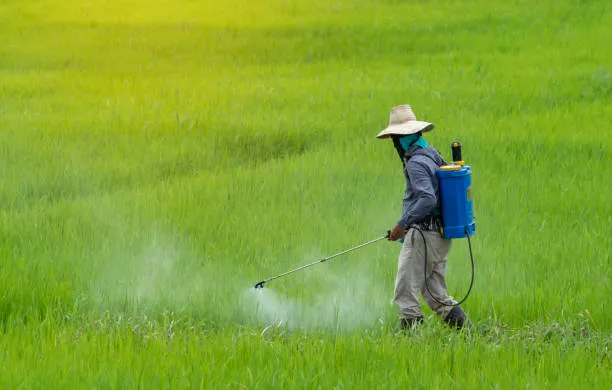Introduction
In modern agriculture, fungal diseases pose a significant threat to crop yield and quality. To combat these challenges, farmers rely on broad-spectrum fungicides like Tebuconazole 18.3% + Azoxystrobin 11% SC (Spectrum). This combination fungicide offers dual-mode action, providing both preventive and curative control against a wide range of fungal pathogens.
This blog provides a detailed, plagiarism-free overview of Spectrum fungicide, covering its composition, mode of action, benefits, target diseases, application methods, safety precautions, and environmental considerations.
What is Tebuconazole 18.3% + Azoxystrobin 11% SC (Spectrum)?
Spectrum is a suspension concentrate (SC) fungicide combining two active ingredients:
- Tebuconazole (18.3%) – A systemic triazole fungicide (DMI inhibitor)
- Azoxystrobin (11%) – A broad-spectrum strobilurin fungicide (QoI inhibitor)
This dual-action formula ensures long-lasting protection against fungal infections in various crops, including rice, wheat, vegetables, fruits, and pulses.
Mode of Action
1. Tebuconazole (Triazole Fungicide)
- Inhibits ergosterol biosynthesis, a key component of fungal cell membranes.
- Disrupts fungal growth and reproduction.
- Provides systemic and curative action, controlling existing infections.
2. Azoxystrobin (Strobilurin Fungicide)
- Blocks mitochondrial respiration by inhibiting the QoI (Quinone outside Inhibitor) site in fungi.
- Prevents spore germination and mycelial growth.
- Offers protective and anti-sporulant effects, reducing disease spread.
Combined Benefits:
- Enhanced disease control due to dual mechanisms.
- Reduced risk of resistance (since two different modes of action are involved).
- Longer residual activity compared to single-ingredient fungicides.
Key Benefits of Spectrum Fungicide
- Broad-Spectrum Control – Effective against leaf spots, blights, rusts, powdery mildew, and sheath blight.
- Systemic + Contact Action – Moves within the plant (systemic) while also protecting the surface (contact).
- Improved Plant Health – Enhances photosynthesis and stress tolerance, leading to better yields.
- Rainfastness – Adheres well to leaves, reducing wash-off.
- Compatibility – Can be mixed with other agrochemicals (check label before use).
Target Diseases & Crops
1. Rice
- Sheath Blight (Rhizoctonia solani)
- Blast (Pyricularia oryzae)
- Brown Spot (Bipolaris oryzae)
2. Wheat
- Leaf Rust (Puccinia triticina)
- Powdery Mildew (Blumeria graminis)
- Septoria Leaf Spot (Septoria tritici)
3. Vegetables (Tomato, Potato, Chilli, Onion)
- Early Blight (Alternaria solani)
- Late Blight (Phytophthora infestans)
- Anthracnose (Colletotrichum spp.)
4. Fruits (Grapes, Mango, Banana)
- Downy Mildew (Plasmopara viticola)
- Powdery Mildew (Erysiphe spp.)
- Sigatoka Disease (Mycosphaerella spp.)
Recommended Dosage & Application Method
1. Foliar Spray (Most Common Method)
- Dilution: Mix 1.0–1.5 mL per liter of water (or as per label instructions).
- Spray Volume: 200–400 L/ha (depending on crop canopy).
- Timing: Apply at first disease symptoms or preventively in high-risk conditions.
- Frequency: 2–3 sprays at 10–15 day intervals.
2. Seed Treatment (For Certain Crops)
- Dosage: 2–3 mL per kg of seeds (check label for specific crops).
- Method: Coat seeds uniformly and allow drying before sowing.
3. Soil Drench (For Soil-Borne Pathogens)
- Dilution: 2–3 mL per liter of water, applied near the root zone.
Safety Precautions & Handling
- Wear PPE: Gloves, mask, goggles, and full-sleeved clothing.
- Avoid Inhalation: Do not breathe spray mist.
- No Eating/Drinking During Use: Prevent accidental ingestion.
- Storage: Keep in a cool, dry place, away from food and feed.
- Disposal: Rinse containers thrice before disposal.
Environmental & Resistance Management
- Toxic to Fish & Aquatic Life – Avoid contamination of water bodies.
- Moderately Toxic to Bees – Avoid spraying during flowering.
- Resistance Risk: To delay resistance, rotate with non-QoI fungicides (e.g., mancozeb, copper-based fungicides).
Conclusion
Tebuconazole 18.3% + Azoxystrobin 11% SC (Spectrum) is a highly effective fungicide for managing a wide range of fungal diseases in multiple crops. Its dual-action formula ensures better disease control, improved plant health, and higher yields.
However, responsible usage is crucial to minimize resistance risks and environmental impact. Always follow label instructions, use proper protective gear, and adopt integrated disease management (IDM) practices for sustainable farming.
Final Recommendation
For best results:
Apply preventively before disease outbreaks.
Rotate with other fungicide groups to avoid resistance.
Monitor crops regularly for early symptoms.
By using Spectrum fungicide wisely, farmers can achieve healthier crops and higher profitability while maintaining ecological balance.
Disclaimer: Always follow the product label and local regulations. Consult an agronomist for crop-specific recommendations.
Sourashis Chanda brings readers their unique perspective on Business, Economy, Health and Fitness. With a background in Health and Physical Fitness of 2years, I am dedicated to exploring [what they aim to achieve with their writing, on the sustainable Economy of the country, various pro tips about business, latest goverment news, with some tips in health are and Fitness.







